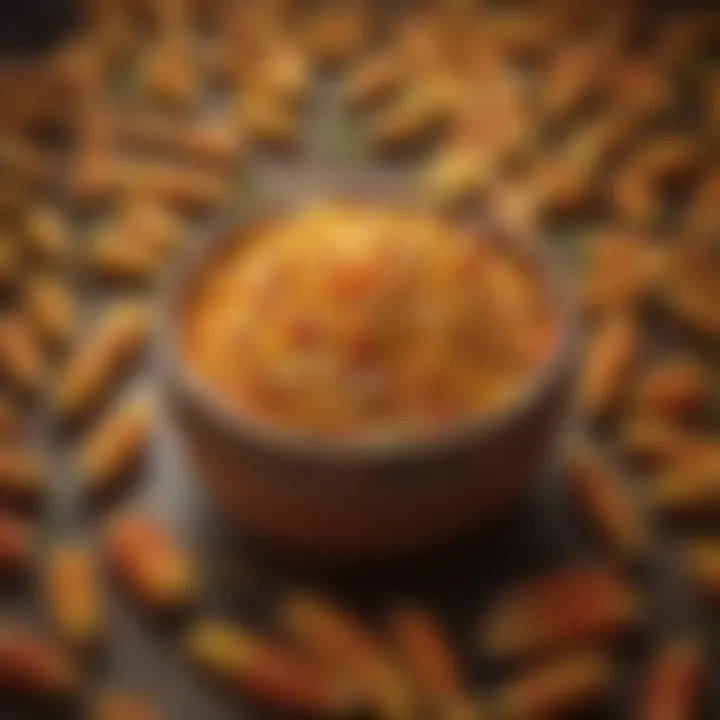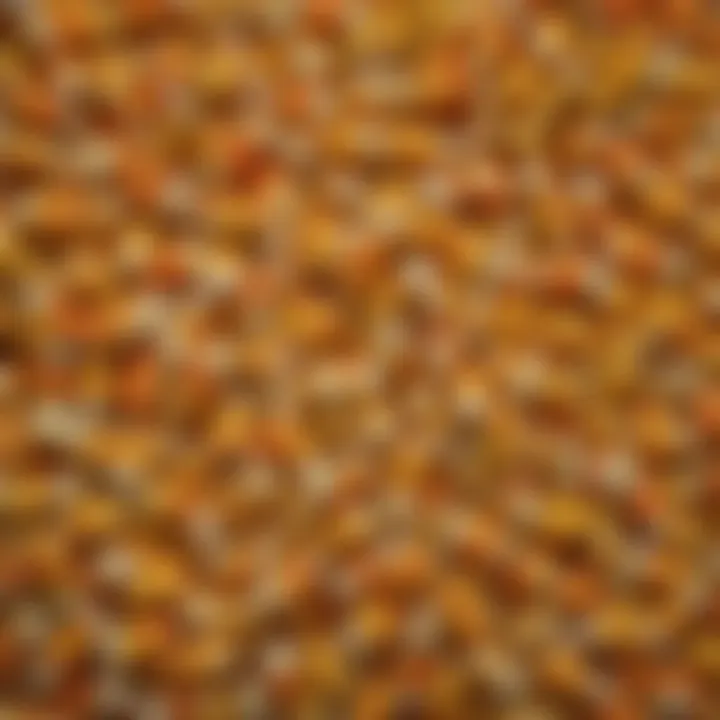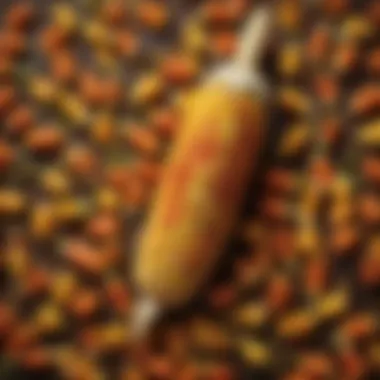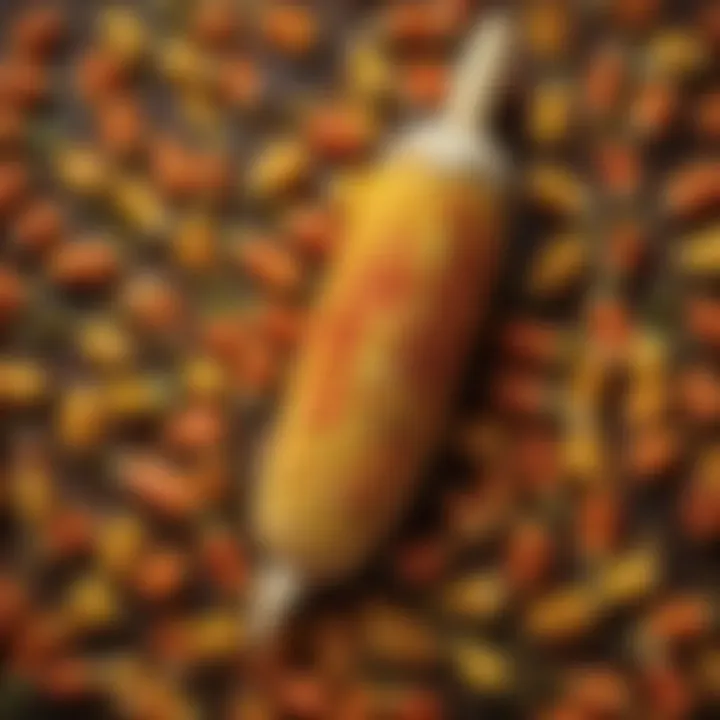Candy Sweet Corn: An In-Depth Analysis of a Seasonal Treat


Intro
Candy sweet corn evokes a unique blend of nostalgia and curiosity. This candy, often linked to autumn festivities, is more than just a seasonal favorite. Its origins trace back to the early 20th century, conjuring memories of Halloween and festive gatherings. However, the matter of its ingredients, production processes, and cultural implications deserves a closer examination. This discussion reveals a layered understanding of candy sweet corn, transcending its role as merely a sugary indulgence.
We will delve into the key aspects of candy sweet corn, including its historical context, the array of ingredients that form this confection, and the variations that have emerged over time. Furthermore, we will explore its nutritional properties and how it fits into modern culinary practices. Together, these elements paint a holistic picture of why candy sweet corn is more than just a treat; it is a significant part of many cultural traditions and consumer habits.
Recipe Overview
While candy sweet corn is often found packaged and ready to eat, its homemade versions can add a personal touch that enhances the experience.
Recipe Name and Description
Candy Sweet Corn is a sugary, edible representation of the iconic vegetable, crafted to mimic its appearance and flavor. The recipe involves cooking sugar, corn syrup, and other ingredients to create a chewy texture and vibrant color. This homemade version allows for customization in flavors and colors, fostering more engagement with the culinary process.
Cuisine Type
While candy sweet corn does not fit neatly into a specific culinary category, it is often associated with American cuisine. It has established itself as a staple in Halloween celebrations and is commonly found in seasonal candy assortments.
Ingredients List
To create authentic candy sweet corn, several key ingredients are required. Each plays a pivotal role in both flavor and texture.
- Granulated Sugar: The main building block for sweetness.
- Corn Syrup: Provides chewiness and prevents crystallization.
- Butter: Adds richness and enhances flavor.
- Milk Powder: Contributes creaminess.
- Food Coloring: For achieving the classic yellow, orange, and white hues.
- Natural Flavors: Often vanilla or other flavorings for depth.
Detailed Ingredient Breakdown
Each ingredient serves a specifically designed purpose in making candy sweet corn. For instance, the granulated sugar, when heated, becomes the primary sweetener, while corn syrup maintains the soft texture making it pleasant to chew. Butter is paramount for achieving a creamy undertone. The use of milk powder allows for a more complex flavor profile, balancing the sweetness. The layers of color achieved with food coloring not only resemble real corn but also appeal to the visual senses.
Substitutions for Dietary Needs
Adapting candy sweet corn for dietary preferences is possible:
- Vegan Option: Substitute butter with coconut oil for a plant-based alternative.
- Nut-Free: Ensure that any added flavoring is nut-free and check for cross-contamination.
- Sugar-Free: Use sugar substitutes like erythritol or stevia; adjust for sweetness accordingly.
Ending
Candy sweet corn leads us into the nexus of culture and cuisine. By understanding its ingredients and methods, we can appreciate not only the treat itself but also the traditions and practices that surround it. As we explore the various themes surrounding this candy, the true nature of its place within culinary history and contemporary consumer trends will become clearer.
Prelude to Candy Sweet Corn
Candy sweet corn is more than just a festive treat. This section lays the groundwork for understanding its many facets, from its concept to its connections with culture and community. Recognizing its significance helps in appreciating how candy sweet corn influences culinary practices, consumer behaviors, and seasonal traditions. It serves as a bridge between enjoyable flavors and deeper nutritional discussions, making it pivotal in the exploration of this confectionery.
Definition and Basic Characteristics
Candy sweet corn refers to a type of candy shaped like kernels of corn, usually colored in shades of yellow and orange. Each piece is soft and chewy, designed to resemble corn while delivering a sugary sweetness. The unique texture sets it apart from many other types of candy. It is often associated with autumn and is primarily consumed during Halloween.
In terms of confectionery characteristics, candy sweet corn is notable for its multi-layer appearance and flavor profile. The layers typically represent a creamy texture that contributes to its signature taste. The sweet, rich flavor makes it distinct within the spectrum of sugary snacks. Primarily, it combines sugar, corn syrup, and other ingredients to produce its well-known taste and feel.
Historical Overview
The origins of candy sweet corn trace back to the late 19th century, around the 1880s. It was initially created by George Renninger, a worker at the Wunderle Candy Company. Early versions were not as uniform and bright as today's products; they were handmade and lacked the colorful coating. Over time, the invention sparked particularly among American consumers, becoming an iconic seasonal product.
In the decades that followed, candy sweet corn developed a strong association with Halloween festivities and harvest celebrations. The manufacturing processes evolved, incorporating mass production techniques to meet rising demand. The confection flourished, particularly post-World War II, representing abundance and joy during festive seasons. Its enduring presence in the candy landscape is a testament to its successful adaptation and cultural resonance, encapsulating both nostalgia and celebration.
Ingredients of Candy Sweet Corn


Understanding the ingredients of candy sweet corn is crucial for several reasons. It allows consumers to appreciate the balance between taste, texture, and nutritional content. Moreover, knowing these elements can help buyers make informed choices, especially those with dietary restrictions or health considerations.
Key Ingredients
The primary components of candy sweet corn include sugar, corn syrup, and various flavors. Sugar is the main ingredient. It contributes to the sweet taste that defines candy sweet corn. Corn syrup provides moisture and helps to improve the overall texture. Together with glucose, these ingredients create a chewy yet soft consistency. Other essential ingredients include:
- Artificial flavors: These enhance the overall experience and are often available in multiple taste options such as vanilla, butter, and even seasonal flavors.
- Coloring agents: Bright colors make candy sweet corn visually appealing. Common colors include yellow, white, and orange, which emulate real corn varieties.
- Gelatin or pectin: These components help provide structure. They also ensure the candy maintains its shape and consistency without becoming overly sticky.
- Preservatives: These extend shelf life and keep the product fresh for longer periods.
While many brands offer versions that contain these common ingredients, specific recipes may opt for all-natural alternatives. This can include natural colorants and organic sugar, appealing to health-conscious consumers.
Nutritional Information
The nutritional profile of candy sweet corn is a topic often subject to scrutiny. A standard serving can vary widely by brand, so it is essential to check packaging for accuracy. Generally, a serving of candy sweet corn might contain approximately:
- Calories: About 140-150 calories per serving
- Total Fat: Negligible fat content, typically less than one gram
- Sodium: Low sodium, around 5-15 mg
- Total Carbohydrates: Roughly 35-40 grams, primarily from sugars
- Protein: Minimal, usually less than one gram
These values highlight that candy sweet corn is primarily a sugar-based product. Its appeal lies in its taste rather than its nutritional content. While occasional consumption is fine for most, overindulgence can lead to health risks like weight gain and increased blood sugar levels.
"Understanding the ingredients allows consumers to appreciate the balance between taste and nutritional value."
Many brands have responded to increasing health awareness by offering options that are lower in sugar or calorie content. This shift caters to consumers who still wish to enjoy candy sweet corn without excessive intake of refined sugars. This evolution in choices reflects changing consumer preferences, emphasizing fun treats that can still align with a health-conscious lifestyle.
Manufacturing Process
The manufacturing process of candy sweet corn plays a crucial role in determining its quality and distinct characteristics. This section explores the elements involved in creating this iconic confection, examining how each step contributes to the final product. Understanding the manufacturing process not only informs consumers but also suppliers and producers about the best practices needed to maintain quality and appeal in a competitive market.
Ingredients Selection
The first stage of the manufacturing process is the selection of ingredients, which directly influence the flavor, texture, and appearance of candy sweet corn. The primary ingredients typically include corn syrup, sugar, and modified food starch, but variations may include additional flavorings and colors.
Careful sourcing is necessary; the corn syrup must meet precise sweetness levels. Sugar can range from granulated to powdered types, each contributing differently to the consistency of the candy. Modified food starch is vital for binding and shaping, ensuring that the sweet corn retains its iconic form. Brands like Brach's are known for their particular formulations, which often include unique flavor profiles.
Overall, the choice of quality ingredients is fundamental, affecting both the taste and safety of the product.
Production Techniques
Once all ingredients are gathered, the production techniques determine how candy sweet corn is formed and shaped. The process usually begins with mixing the corn syrup and sugar over heat until the mixture reaches a specific temperature. At that point, the modified food starch is added, creating a thick, malleable base.
This mixture is then cooled and put into molds that define the shape of the candy. Heat is carefully monitored; too high a temperature can lead to burning, altering flavor and texture. A common technique is to use a rotating drum to mix the ingredients evenly while they cool. This ensures a consistent final product.
After molding, the mixture is set aside to allow for crystallization. Different manufacturers may apply unique techniques, resulting in variations in texture. Some may choose to introduce air into the mixture, creating a lighter chew. Others might rely on denser formulations for a more traditional bite.
Quality Control Methods
Quality control is an essential part of the manufacturing process, ensuring that each batch of candy sweet corn meets established standards. This includes checking the ingredients for freshness and ensuring proper measurements during production. Key aspects to monitor include:
- Visual Inspection: Checking for consistency in color and shape.
- Sample Testing: Conducting taste tests on samples from each batch to ensure flavor accuracy and overall quality.
- Texture Analysis: Using equipment to measure the hardness or chewiness of the candy, which can affect consumer preference.
The importance of quality control cannot be overstated. It helps maintain brand reputation and consumer trust. Any deviation from quality can lead to product recalls or customer complaints, which can seriously damage a brand's image.
"A consistent quality control process increases brand loyalty among consumers, which is vital in the candy industry."
In summary, the manufacturing process of candy sweet corn is a detailed interplay of ingredient selection, production techniques, and vigilant quality control methods. Each component is critical for producing a product that consumers recognize and enjoy. By delving into these elements, we gain a clearer understanding of how candy sweet corn evolves from simple ingredients into a beloved treat.
Cultural Significance


Understanding the cultural significance of candy sweet corn reveals its deeper role beyond mere seasonal confectionery. This treat, with its vibrant colors and distinct taste, has become an icon of autumnal celebrations and is often associated with community gatherings and family traditions. This section explores essential elements regarding the cultural aspects tied to candy sweet corn.
Seasonal Associations
Candy sweet corn primarily finds its resonance during the fall, particularly around Halloween and Thanksgiving. Its appearance signals the change of seasons, inviting consumers to engage in festivities that celebrate harvest time. Families incorporate sweet corn into their holiday routines, often using it as decorations or treats during parties.
This seasonality fosters a communal spirit. When children collect candy during Halloween or families gather for Thanksgiving, candy sweet corn serves as a reminder of joy and shared experiences. In many cultures, the sweet corn is not merely a treat; it represents the nostalgia of childhood and the warmth of family ties during colder months.
Festivals and Traditions
Throughout various regions, festivals highlight candy sweet corn in unique ways. Corn mazes, fall fairs, and harvest festivals often feature candy sweet corn prominently. These events celebrate not just the crop itself but also the labor and culture surrounding it, drawing connections between agricultural practices and culinary traditions.
In the United States, for example, Halloween festivities often lead to increased consumption of candy sweet corn. Its distinct look and taste have been championed in various social media campaigns and seasonal advertising. The treat's playful colors vividly link it to childhood memories and celebratory moments.
In summary, candy sweet corn is not just a festive treat; it embodies tradition and community values, reinforcing its position as an essential element of cultural significance. Its integration into seasonal events nurtures connections among individuals and families, bringing a sense of unity during celebratory times.
Variations of Candy Sweet Corn
The subject of variations of candy sweet corn is critical to understanding its multifaceted nature as a confection. These variations not only reflect consumer preferences but also highlight the creativity in the candy-making industry. With a myriad of flavor combinations and shapes available, candy sweet corn appeals to a broad audience, allowing for personalization and exploration among food lovers of all ages.
Flavor Combinations
Among the most significant aspects of candy sweet corn is its ability to adapt flavors. Traditional candy sweet corn typically features a simple, sweet taste that is reminiscent of vanilla and honey. However, it has evolved far beyond this basic profile, incorporating a range of flavors designed to intrigue and excite the palate. Common variations can include:
- Pumpkin Spice: Capturing the essence of fall, this flavor brings warmth and nostalgia, matching seasonal trends.
- Chocolate-Covered: A modern twist where candy sweet corn is dipped in chocolate, presenting a delightful contrast between creamy and sugary.
- Fruit Flavors: From peach to blueberry, these combinations offer refreshing twists that appeal to those looking for something fruity.
These flavor innovations not only cement candy sweet corn’s seasonal relevance but also allow it to thrive in various markets. The ability to experiment and adapt makes this candy a favorite among manufacturers and consumers alike. The experimentation with flavors can lead to limited-edition releases, keeping the product fresh and anticipated.
Shape and Form Variability
In addition to flavor, the shape and form variability of candy sweet corn is another element that enhances its appeal. The classic shape of candy corn is triangular but several adaptations exist. These may feature:
- Mini Corn Kernels: Smaller versions that are easier to consume in larger quantities.
- Multi-Colored Versions: Some manufacturers blend colors and shapes to create visually stimulating products.
- Gummy Variants: Combining the distinct shape of candy corn with gummy texture creates a completely new candy experience.
By varying shapes, manufacturers can tap into specific trends or audience interests. For instance, during Halloween, unique designs may emphasize festive themes, while in summer, lighter styles might be preferred.
Candy Sweet Corn in Popular Culture
Candy sweet corn has cemented its place in the cultural fabric of various societies, especially in the United States. This confectionery, often tied to autumn festivities, transcends the sheer enjoyment of taste and texture. It raises questions about nostalgia, trend cycles, and how food can integrate into different contexts. Understanding its importance in popular culture can provide insights into consumer behavior, seasonal marketing strategies, and even artistic expressions influenced by this treat.
Media Representation
In media, candy sweet corn is frequently portrayed as a symbol of childhood and festive times, particularly around Halloween. Television shows and movies often feature characters eagerly anticipating the arrival of this treat, evoking a sense of nostalgia. Advertisements typically link candy corn with family gatherings and celebrations, amplifying its cultural significance. The image of candy corn can serve not just as a simple decoration but also as a narrative device that connects characters with their past experiences.
Moreover, candy sweet corn appears in various contexts, from cartoons to live-action films, showcasing its versatility in representation. For instance, in certain children’s shows, the candy acts as a central prop, symbolizing happiness and community. This continues to foster a fond memory associated with the treat.
Social Media Trends
The advent of social media has significantly influenced the presence of candy sweet corn. Users share images and create content centered around this candy, often highlighting its colorful appeal or unique flavors. Platforms like Instagram and TikTok have become a canvas for creative expressions involving candy corn, where recipes, DIY projects, and savory combinations are shared widely.
In recent years, social media trends have birthed challenges and hashtags that celebrate candy sweet corn. These trends encourage engagement through creative cooking or artistic presentations, thus keeping the candy relevant among diverse age groups. Additionally, memes incorporating candy corn reflect both admiration and parody, showcasing its polarizing nature among consumers.
Ultimately, social media provides an avenue for dialogue about candy sweet corn that was not as accessible before. This keeps the discourse active and supports the candy’s presence throughout the year, not just during the fall season.
"Candy sweet corn goes beyond being just a seasonal treat; it embodies cultural connections and undergoes transformations through various media and social platforms."


Consumer Trends and Marketing
Understanding consumer trends and marketing strategies is crucial in appreciating the landscape of candy sweet corn. The popularity of this seasonal treat is influenced by various factors including changing consumer preferences, cultural perceptions, and demographic shifts. These trends shape how manufacturers communicate and engage with their audience.
Market Demographics
The demographics surrounding candy sweet corn play a significant role in its marketing. This confection has a diverse consumer base that ranges from children to adults. Key demographics include:
- Age Groups: Children often form a primary consumer segment due to its colorful appearance and association with festive occasions. However, adults also indulge in candy sweet corn, especially during seasonal celebrations like Halloween.
- Geographic Locations: This treat is particularly popular in North America, where it is a staple during autumn. Understanding regional preferences can aid companies in crafting targeted marketing campaigns that resonate with local consumers.
- Socioeconomic Factors: Candy sweet corn is generally affordable, making it accessible to a wide range of income levels. This broad appeal has significant implications for sales strategies.
The convergence of these demographics presents opportunities for marketers to tailor their strategies, ensuring they meet the needs of specific audiences effectively.
Advertising Strategies
Advertising strategies for candy sweet corn must capitalize on its unique qualities and seasonal nature. Here are some effective approaches:
- Seasonal Campaigns: Given the treat’s strong association with autumn and Halloween, marketers frequently launch campaigns during this period. Promotions often highlight its links to nostalgia and tradition, appealing to both children and adults.
- Social Media Engagement: Platforms like Facebook and Instagram have become vital for reaching consumers. Engaging visuals and interactive content can generate excitement. Using hashtags like #CandyCorn has proven beneficial in creating a community around this treat.
- Influencer Collaborations: Partnering with food influencers or bloggers can amplify reach. Their endorsements provide social proof, influencing followers' purchasing decisions.
- Promotional Offers: Special discounts or limited-time offers can stimulate interest. Bundling candy sweet corn with other seasonal treats may enhance sales and attract customers.
"Effective advertising not only showcases the product but also resonates with customers' emotions and experiences associated with that product."
In summary, understanding consumer trends and employing targeted marketing strategies strengthen the market presence of candy sweet corn. By tapping into demographics and executing thoughtful advertising, companies can enhance their engagement and sales with this popular confection.
Health Considerations
Health considerations regarding candy sweet corn are essential for an understanding of its role not just as a seasonal treat, but also as a food product that impacts dietary choices and public health. Consumers today are increasingly conscious of what they consume and how it affects their health. Therefore, examining the potential health risks associated with candy sweet corn, as well as exploring healthier alternatives, creates a well-rounded narrative that benefits informed decision-making.
Potential Health Risks
Candy sweet corn is primarily composed of sugar, high fructose corn syrup, and other sweetening agents. It is important to recognize that excessive consumption poses potential health risks, including:
- High Sugar Intake: Consuming large amounts of sugar can lead to increased risk of obesity, Type 2 diabetes, and tooth decay.
- Additives and Preservatives: Many brands of candy sweet corn contain artificial colorings and preservatives. These have been associated with adverse health effects in some cases, particularly concerning hyperactivity in children.
- Lack of Nutritional Value: The confection lacks significant vitamins and minerals, making it less beneficial from a nutritional standpoint. A diet high in sugar-heavy snacks may contribute to nutritional deficiencies, as it can replace more nutrient-dense food options.
While enjoying candy sweet corn in moderation can be part of a balanced diet, consumers should be mindful of these potential risks.
"The increasing awareness of health risks associated with excessive sugar consumption highlights the need for consumers to be educated about the products they choose to include in their diets."
Healthier Alternatives
Exploring healthier options can enhance the enjoyment of candy sweet corn without compromising health goals. Here are some alternatives:
- Homemade Versions: Making candy sweet corn at home allows for control over ingredients. By reducing sugar or using natural sweeteners like honey or maple syrup, one can create a less sugary treat.
- Fruit-Based Snacks: Fruit snacks, such as dried mango or apple slices, offer natural sweetness along with added vitamins and fiber, making them a better choice compared to candy sweet corn.
- Nuts and Seeds: Nuts and seeds provide a healthy crunch and are high in protein. They can be combined with small amounts of dark chocolate for a satisfying sweet treat without the excess sugar.
- Natural Candy: Some brands produce candy sweet corn with all-natural ingredients and little added sugar. Research these options for a treat that aligns more closely with health goals.
Incorporating healthier alternatives into one’s diet supports a well-rounded approach to both enjoyment and health management, allowing individuals to cherish seasonal treats without the negative implications.
Ending and Future Trends
The exploration of candy sweet corn has revealed its multifaceted nature, encompassing cultural, nutritional, and manufacturing aspects. This conclusion synthesizes key insights while shedding light on future trends that may influence its reputation and consumption.
Sustainability in Production
Sustainable production methods are increasingly important in the confectionery industry. Candy manufacturers are beginning to recognize the need for environmentally friendly practices. One step towards sustainability is sourcing ingredients from responsible suppliers. For example, using non-GMO corn can reduce the environmental impact of cultivation.
Additionally, some companies are adopting eco-friendly packaging to minimize waste. The shift towards sustainability not only addresses consumer demand for greener products but also enhances brand reputation. As consumers become more conscious of their choices, the expectation for candy sweet corn to align with these values will grow. Producers who embrace sustainable practices may find themselves favored by eco-conscious customers.
Evolving Tastes and Preferences
Tastes in confectionery are continually evolving. Current trends show an increasing interest in unique flavor profiles that go beyond traditional sweet corn. Here, we see a potential for innovation, as producers experiment with fusion flavors and healthier alternatives. For instance, incorporating natural sweeteners or exotic spices can appeal to a broader audience.
Moreover, the rise of plant-based diets presents an opportunity for candy sweet corn to diversify. Products that cater to vegans or those seeking allergen-free options can tap into a growing market segment. As preferences shift, manufacturers should remain agile, adapting to the changing landscape while staying true to the nostalgic charm of candy sweet corn.
"The future of candy sweet corn hinges on its ability to combine tradition with innovation, ensuring its place in a rapidly changing market."
In summary, the future of candy sweet corn lies in embracing sustainability and responding to evolving consumer tastes. By prioritizing these elements, the industry can remain relevant and appealing for generations to come.















